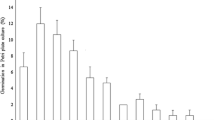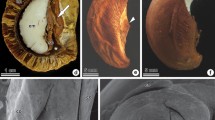Abstract
IT appears that dormant rose achenes of many species may be put in the same category as those ‘two-year’ seeds which require a warm period in the soil to permit disintegration of the coat, followed by a period at low temperature to after-ripen the embryo. On the other hand, Harrison1 reports that achenes of R. arvensis germinated in good numbers in the first year after planting in the autumn under natural conditions. This behaviour appears to be characteristic of members of the section Synstylae2 and also to some extent of R. rugosa3.
Similar content being viewed by others
References
Harrison, J. W. H. (personal communication).
Rowley, G. D., Amer. Rose Annual, 41, 70 (1956).
Tincker, M. A. H., J. Roy. Hort. Soc., 60, 399 (1935).
Jackson, G. A. D., and Blundell, J. B., J. Hort. Sci., 38, 310 (1963).
Varga, M., Acta Biol. Hung., 7, 39 (1957).
Varga, M., Acta Biol. Hung., 9, 369 (1959).
Bennet-Clark, T. A., and Kefford, N. P., Nature, 171, 645 (1953).
Author information
Authors and Affiliations
Rights and permissions
About this article
Cite this article
JACKSON, G., BLUNDELL, J. Germination of Rosa arvensis. Nature 205, 518–519 (1965). https://doi.org/10.1038/205518a0
Published:
Issue Date:
DOI: https://doi.org/10.1038/205518a0
- Springer Nature Limited
This article is cited by
-
Embryo and hip development in hybrid roses
Plant Growth Regulation (2013)
-
The identification of (+)-abscisin II [(+)-dormin] in plants and measurement of its concentrations
Planta (1967)





